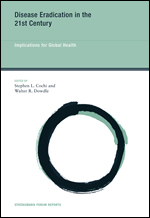Disease Eradication in the Context of
Global Health in the 21st Century
Stephen L. Cochi, Chairperson
August 29–September 3, 2010
Frankfurt am Main, Germany
Program Advisory Committee:
Bruce Aylward, Global Polio Eradication Initiative, World Health Organization, Avenue Appia
20, CH-1211 Geneva 27, Switzerland
Stephen L. Cochi, National Center for Immunization and Respiratory Diseases, Centers for
Diesease Control and Prevention, 1600 Clifton Road, NE, Mailstop E-05, Atlanta, GA 30333,
U.S.A.
John O. Gyapong, University of Ghana, School of Public Health, Department of Epidemiology
and Disease Control, P.O. Box LG 13, Accra, Ghana
David Molyneux, Liverpool School of Tropical Medicine, Pembroke Place, Liverpool L3 5QA,
U.K.
Eric A. Ottesen, Filariasis Support Center, Task Force for Child Survival and Development, 325
Swanton Way, Decatur, GA 30030, U.S.A.
Regina Rabinovich, Global Health Program, Bill and Melinda Gates Foundation, P.O. Box 23350,
Seattle, WA 98102, U.S.A.
Background, Purpose, and Need for this Forum
Mankind will always have a fascination with the eradication of diseases and scourges from the human population. Disease eradication was achieved for the first (and only) time in 1980 when the World Health Assembly declared the world free of smallpox following a campaign lasting more than ten years. Success in eradicating smallpox worldwide led to an increasingly intensive examination of the concepts and definitions associated with disease eradication with development of general and specific criteria as predictors of success for particular candidate diseases. The Carter Center International Task Force for Disease Eradication initiated a formal review of candidate diseases in 1988 and is currently completing a second review. The criteria for eradication were comprehensively examined at a workshop in 1997 on The Eradication of Infectious Diseases (Dowdle and Hopkins 1998), followed in 1998 by an expanded global forum on Disease Eradication and Elimination as Public Health Strategies (WHO 1998). More than a decade has passed since the basic eradication concepts and issues have been systematically addressed. Meanwhile, considerable experience has been gained in efforts to eradicate polio and dracunculiasis; and in efforts to eliminate such diseases as measles, maternal and neonatal tetanus, onchocerchiasis, and lymphatic filariasis. Concepts of disease eradication have continued to evolve, influenced by scientific advances, field experiences, societal issues, and economic realities.
The need to convene a workshop on disease eradication is especially timely since heightened interest in the potential eradication of various infectious diseases is once again moving front and center. For example, at the May 2008 meeting of the Executive Board (EB) of the World Health Assembly, the Board requested that WHO examine the feasibility of global measles eradication and report back to the EB in 2010. Also in 2008, both WHO and the Bill and Melinda Gates Foundation publicly called for development of a program of work to achieve malaria eradication in the longer term. These examples are illustrative of the ongoing fascination with the concept of eradication. They also demonstrate the continuing need to ensure that such initiatives are carefully considered based on a full understanding of the biological, political, social, and economic complexities associated with a successful eradication program. With increasing interest in identifying candidate diseases for eradication, these complexities need to be addressed for the benefit of public health decision-makers, politicians, scientists, and the world at large. The proposed workshop can provide a forum to develop a framework for a priority-setting process to identify the most worthy candidates for disease eradication (the "what?") and the critical factors for success (the "how?"). The rapid accumulation of knowledge since the 1990s, together with radical changes in the global landscape, requires an in-depth, systematic reassessment and re-examination of eradication in the context of global health in the 21st century.
Top of page
![]()
